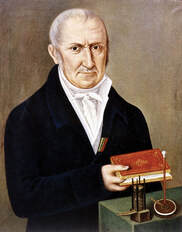'Don't be sour; its been a lemon of a year' -- Isabella Schainker 7th grade

Come with the mindset that the few jokes and puns are meant to be bad, it could be a metaphor, you just never know. Pucker up, pack for your persistence, and prepare for some unripe comedy. Sweet and sour of facts and funny.
Lemon batteries are well known in the world of chemistry but when asked how they work, people usually are left confused. From lemon seeds to batt-trees, a lemon battery illustrates the type of chemical reaction that usually occurs. The zinc nails and copper are called the electrodes, a conductor through which electricity enters or leaves an object or substance. The lemon juice or citric acid is called the electrolyte, a chemical medium that allows the flow of electrical charge between components of the battery. Don’t be sour, its lemon power.
Allesandro Volta, a well known Italian physicist, chemist, and pioneer of electricity, who is credited as the inventor of the electric battery and the discoverer of methane. While experimenting with different forms of batteries, he made a battery that used salt water. In 1800, Volta announced his invention of the device that produced a small but steady electrical current. His "voltaic pile", as it was titled, operated by placing pieces of cloth soaked in salt water between pairs of zinc and copper discs. This was similar to the idea of the lemon battery today. Volta used a cloth soaked in salt water to flow the electricity from the copper and zinc discs and into the circuit, while the lemon battery uses the lemon’s citric acid to flow the electrical charge from the zinc nails and copper to the circuit.
As stated by Wikipedia, the lemon battery works through an electro-chemical reaction when it is connected to a complete circuit. An electo-chemical reaction refers to converting chemical energy into electrical energy. Citrus in the lemon acts as an electrolyte, a solution that conducts electricity through the reaction between the anode and cathode.
Many citrus fruits could work for making this sort of battery. This includes lemons, limes, oranges, and grapefruit. These fruits will work because they all contain citric acid for the electrolyte. However, according to UpsBatteryCenter, sweet, ripe ones are less effective. Lemons are best to use, they are sub-lime for the experiment. The experiment can be done using apples and pears, though these fruits won’t work quite as well. The citric acid is essential for the experiment, as it is the electrolyte.
The electrolytes in the fruits serve as a catalyst to make a battery conductive by promoting the movement of ions from the cathode to the anode on charge and in reverse on discharge. One of the electrodes in the battery has to have a stronger desire for electrons than the other, in chemistry it is said that it has a higher electro-negativity. The electrode that wants the electrons more is called the cathode and the one that gives up electrons is the anode.
Inside every battery, there are three components: two electrodes (anode and cathode) and an electrolyte (to move charges between the electrodes). In a lemon battery, the copper and zinc act as the electrodes, with copper being the cathode and the zinc or galvanized zinc nail being the anode. The citric acid from the lemon is the electrolyte of the lemon battery. The lemon is not what is creating the electricity, it comes from the differences in electro-negativity between zinc and copper. I assume no one wants a dead battery but they're free of charge.
The Sci Show begs the question: why can’t copper just be hooked to the zinc and the electrons can’t just transfer to make positive and negative? Why do we need the lemon? Electrons aren’t going to abandon their stable location and willingly separate charging the metal into positive on one side and negative on the other. Since the zinc is losing electrons, it will also lose protons, this is where the lemon (electrolyte) comes into play. Using an LED, light-emitting diode circuit, the electrolytes will help electro-light it up. The jokes aren’t good, that's the point, let's continue.
The wire that connects the cathode and anode allows the electrons to flow freely, but the protons are large in comparison and are unable to travel through a wire. The protons can instead move into an ionic solution, such as a dilution of citric acid or lemon juice. When zinc is exposed to the acid, the acid oxidises, or removes the electrons from the zinc and the resulting positively charged zinc ions move in the solution. While the electrons cling to the metal, move across the wire to the copper which as the cathode wants the electrons more than the anode. The protons with the electrons form hydrogen gas. Hydrogen fuel cells produce electricity by combining hydrogen and oxygen atoms. The hydrogen reacts with oxygen across an electrochemical cell similar to that of a real battery to produce electricity. If the experiment doesn’t work out, focus on the experience, everything is full of positives and negatives.
“It's where you take fruit and because of the juice in it and because it’s so acidic, it holds the electrons that can be used to go through wires and create electrical flow,” says Julie Humphrey, Oakland School of the Arts Science teacher. “It works with anything that’s acidic or on the acidic side of things.”
Humphrey states she has done this experiment in the past with lemons and other fruits such as limes, kiwi, bananas, grapefruit, and strawberries in the OSA Science Club. Humphrey says that lemon works the best for a project like this. “I think it might be most acidic,” Humphrey stated. “On the PH scale, it would be the lowest so it has the most spare hydrogens around with the extra electrons.”
Lemon batteries produce a stable but small amount of electricity, making it hard to see a use for them besides just for the sake of the experiment itself. Car companies have been racing towards newer technologies and newer ideas. A Volkswagon carmaker hired former NASA engineer and current YouTuber Mark Rober to build their electric volkswagen a unique charging system. The request had no precise plans, so Rober thought a lemon battery would be a creative way to catch the eye. Rober officially put the lemon-powered car into the Guinness World Records.
It took 1,232 lemons and even higher quantities of the other components to fulfill their plan of making a car that ran on the world’s largest lemon battery. The title was exaggerated since the car was not powered by the lemon, but the reaction between the copper, zinc, and citric acid still created a record. In the end, the battery failed to produce enough power for the car, speaking of lemon law. Although, the experiment did result in a record-breaking car powered by the largest lemon battery. Other companies used an electric vehicle traction battery, Volkswagen used the produce section.
In conclusion, lemon batteries are small, they hold a secret of science and are startlingly complex. This experiment is an interesting, educational experience to explore electricity. It truly has been a lemon of a year and sometimes we don’t feel easy peasy lemon squeezy. Though this is true, we must squeeze the day, make lemon seeds into batt-trees, and remember when life gives you lemons you have a lemon so do with it as you please.


